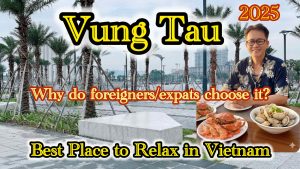10 Golden Reasons Why Thailand Leads Tourism in Southeast Asia

10 Golden Reasons Why Thailand Leads Tourism in Southeast Asia
Introduction
Why does Thailand attract far more international tourists than its Southeast Asian neighbors? According to several reports, more than 50% of visitors to Thailand return for another trip, while in Vietnam, the number is closer to 5%. This stark contrast highlights differences in how the two countries build their tourism industry, develop services, and create memorable travel experiences.
In this article, we will explore 10 golden reasons why Thailand continues to dominate tourism in Southeast Asia. Along the way, we’ll also compare these strengths with Vietnam, a country full of potential but still facing challenges in turning its beauty into a world-class tourism brand.
1. A Global Branding Strategy: “Amazing Thailand”
One of Thailand’s biggest advantages lies in its national marketing strategy. Since the 1990s, the campaign “Amazing Thailand” has been promoted globally on major TV networks such as CNN and BBC. For context, CNN is one of the most famous 24-hour news channels in the United States, while BBC is the UK’s most prestigious international broadcaster. Advertising on these networks meant that Thailand’s image — from smiling locals to beautiful beaches — was broadcast to millions of households worldwide.
By comparison, Vietnam launched campaigns such as “Vietnam – Timeless Charm” and “Live Fully in Vietnam”, but they were not given the same global exposure. As a result, Vietnam’s brand awareness still lags behind Thailand’s well-established image.
2. Modern Transportation and Air Connectivity
Bangkok is a major aviation hub of Asia, with Suvarnabhumi and Don Mueang airports offering hundreds of international flights daily to Europe, the U.S., the Middle East, Japan, and beyond. This convenience makes Thailand an easy first choice for travelers coming to Southeast Asia.
Within the city, transportation is also efficient. The BTS Skytrain, MRT subway, buses, ride-hailing services, and traditional tuk-tuks form a well-connected network. Tourists can move around easily without worrying about heavy traffic.
? Vietnam comparison: Hanoi has launched its first metro line and Ho Chi Minh City is still under construction. Tourists often rely on taxis or motorbikes, which can be overwhelming and less convenient than Thailand’s system.
3. Paradise Islands and Beaches
Thailand’s islands — Phuket, Koh Samui, Krabi, Koh Phi Phi — are world-famous. Beyond stunning scenery, they offer full-package services: beachfront resorts, diving tours, kayaking, and vibrant beach parties.
Thailand also knows how to turn natural beauty into a brand. The movie “The Beach” (2000), filmed at Maya Bay, made this destination a global symbol overnight.
? Vietnam comparison: Ha Long Bay, Da Nang, Nha Trang, and Phu Quoc are equally stunning but lack international marketing campaigns and consistent service quality.
4. Street Food and Night Markets
Thai food has become a global phenomenon. Dishes like Pad Thai, Tom Yum, Green Curry, and Som Tum are enjoyed worldwide. Street food culture in Bangkok and Chiang Mai lets travelers eat delicious meals for just a few dollars while immersing in local life.
Night markets in Thailand combine food, shopping, and entertainment. Tourists can shop, eat, and watch performances in one place — a complete experience.
? Vietnam comparison: While Vietnam’s pho, banh mi, and bun cha are world-famous, night markets often lack variety and organization. They mainly sell food or souvenirs, missing the entertainment factor that keeps tourists engaged.
5. Nightlife & Sex Tourism
Thailand is known for its vibrant nightlife. Cities like Bangkok, Pattaya, and Phuket host red-light districts, cabaret shows, bars, and nightclubs that attract millions of tourists, particularly men from the West.
On the economic side, sex tourism has transformed places like Pattaya from a fishing village into an international tourist city. However, from a humanistic perspective, relying too much on sex tourism raises ethical and social concerns. Thailand has nonetheless chosen to embrace this industry as part of its broader tourism model.
? Vietnam comparison: Vietnam’s nightlife is limited to bars, pubs, and karaoke. Sex tourism is heavily restricted. This helps Vietnam maintain a “safe and family-friendly” image but also makes it less appealing to certain groups of tourists seeking freedom and open entertainment.
6. Medical Tourism & Cosmetic Surgery
Thailand has successfully built a reputation as a hub for medical tourism. International-standard hospitals in Bangkok, Chiang Mai, and Phuket provide everything from dental care and cosmetic surgery to gender reassignment procedures. Prices are a fraction of those in the U.S. or Europe, yet the quality remains high. Many visitors combine treatment with vacation.
? Vietnam comparison: Vietnam has international hospitals but has yet to develop medical tourism into a strong industry. Most foreign patients still choose Thailand for specialized services.
7. Festivals and Cultural Experiences
Thailand hosts spectacular festivals like Songkran (water festival) and Yi Peng (lantern festival). These are not just local traditions but international events that attract millions of visitors. Professional organization and strong promotion ensure they become bucket-list experiences.
? Vietnam comparison: Vietnam’s Tet (Lunar New Year), Perfume Pagoda Festival, and Hung Kings Festival are deeply cultural, but they mainly attract domestic visitors. International promotion and organization remain limited.
8. Friendly People & Professional Service
Thailand is nicknamed the “Land of Smiles” for a reason. From hotel staff to taxi drivers and shopkeepers, Thais are known for their warm attitude and service-oriented mindset.
I once visited a shopping mall in Bangkok where my friend spent nearly 10 minutes choosing clothes without buying anything. The shopkeeper still smiled warmly and thanked us as we left. Even small encounters like this leave lasting impressions.
? Vietnam comparison: Vietnamese people are also warm and hospitable, but inconsistent service quality and occasional “overcharging” have hurt the country’s tourism image.
9. Flexible Costs and Diverse Shopping
Thailand caters to all types of travelers. Backpackers can survive on $30/day, while luxury seekers enjoy five-star resorts. Bangkok is also a shopping paradise, with malls like IconSiam, Siam Paragon, MBK, and CentralWorld, alongside local markets like Chatuchak.
? Vietnam comparison: Vietnam is affordable, especially for food and lodging, but shopping is not yet a strong point. Malls are smaller in scale, and markets lack international appeal.
10. Safety and Integrated Tourism Infrastructure
Thailand has invested heavily in integrated infrastructure. Airports, resorts, malls, and healthcare facilities are interconnected. Tourist Police patrol major destinations to ensure safety and help visitors. This creates trust and encourages longer stays.
? Vietnam comparison: Vietnam is improving its infrastructure, but uncoordinated planning and problems like scams, traffic, and safety issues remain challenges.
Conclusion
I share these points not to criticize Vietnam, but out of honesty. Vietnam is my homeland, the place that gave me my childhood memories and the resilience to succeed abroad. However, it’s also clear that Thailand currently outperforms Vietnam in tourism across many dimensions.
That’s why over 50% of tourists return to Thailand, while only around 5% return to Vietnam. My hope is that Vietnam will learn from Thailand’s success and rise as a global tourism leader.
Thank you for listening to this honest reflection. I wish everyone peace and happiness.
ThailandTourism #LandOfSmiles #SoutheastAsiaTravel #GlobalTourism #TravelComparison #ThailandVsVietnam #10GoldenReasons #InternationalTourism




